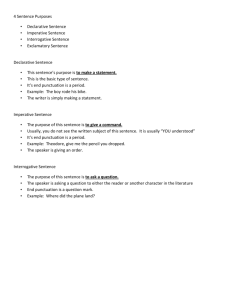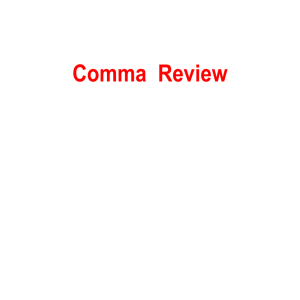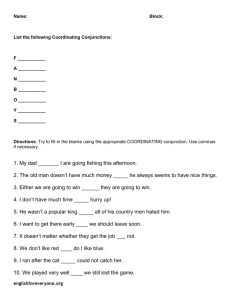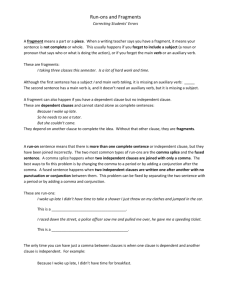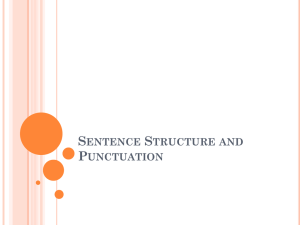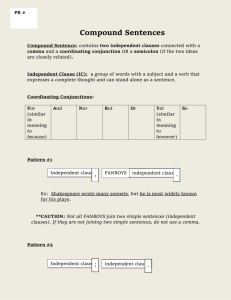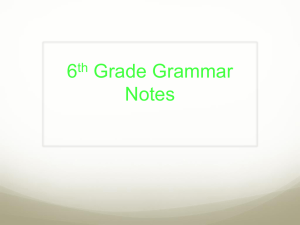Punctuation: Commas, Semi-colons and Colons (First slide
advertisement
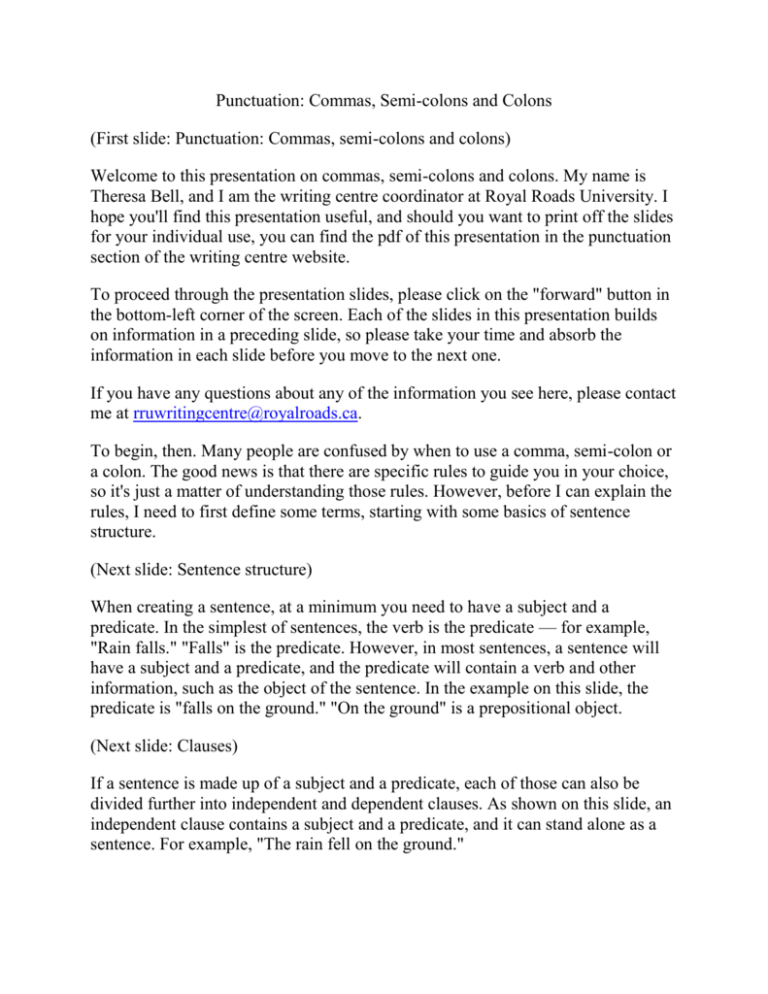
Punctuation: Commas, Semi-colons and Colons (First slide: Punctuation: Commas, semi-colons and colons) Welcome to this presentation on commas, semi-colons and colons. My name is Theresa Bell, and I am the writing centre coordinator at Royal Roads University. I hope you'll find this presentation useful, and should you want to print off the slides for your individual use, you can find the pdf of this presentation in the punctuation section of the writing centre website. To proceed through the presentation slides, please click on the "forward" button in the bottom-left corner of the screen. Each of the slides in this presentation builds on information in a preceding slide, so please take your time and absorb the information in each slide before you move to the next one. If you have any questions about any of the information you see here, please contact me at rruwritingcentre@royalroads.ca. To begin, then. Many people are confused by when to use a comma, semi-colon or a colon. The good news is that there are specific rules to guide you in your choice, so it's just a matter of understanding those rules. However, before I can explain the rules, I need to first define some terms, starting with some basics of sentence structure. (Next slide: Sentence structure) When creating a sentence, at a minimum you need to have a subject and a predicate. In the simplest of sentences, the verb is the predicate — for example, "Rain falls." "Falls" is the predicate. However, in most sentences, a sentence will have a subject and a predicate, and the predicate will contain a verb and other information, such as the object of the sentence. In the example on this slide, the predicate is "falls on the ground." "On the ground" is a prepositional object. (Next slide: Clauses) If a sentence is made up of a subject and a predicate, each of those can also be divided further into independent and dependent clauses. As shown on this slide, an independent clause contains a subject and a predicate, and it can stand alone as a sentence. For example, "The rain fell on the ground." A dependent clause may contain a subject and a predicate, but it needs the rest of the sentence to make sense. Think of what your reaction would be if someone walked up to you and said, "Which made puddles form." You would be confused, because the statement doesn't make any sense on its own. You need the rest of the sentence, which is an independent clause, for the dependent clause to have meaning. For example, "The rain fell on the ground, which made puddles form." (Next slide: Clauses example) This slide contains five sentences, all of which are made up of independent and dependent clauses. The purple text indicates an independent clause, whereas the orange text indicates a dependent clause. You'll see that there are also commas, a semi-colon and a colon in this paragraph. Each mark of punctuation has a connection to independent and dependent clauses, which is why it's important to have a clear understanding of these types of clauses before mastering the punctuation that joins them. (Next slide: Test your knowledge — no audio) (Next slide: Joining clauses) There's just one more slide before we get to commas, and this one covers easy information. Use a coordinating conjunction — such as for, and, nor, but, or, yet, so — to join two independent clauses. Use a subordinate clause — such as which, because, as, since, so, although, though, whereas, while, after — to join an independent clause to a dependent clause. (Next slide: Punctuation: comma) Here we are at last. It's time to talk about commas. You may have been told at some point that you should put a comma in your writing anytime you pause when reading the text. While that is sometimes true, these next few slides will help you understand why you're taking that pause. Rather than relying on a pause to indicate a comma, you'll be able to use the rules to guide you. To begin, looking at rule No. 1: use a comma to join two independent clauses with a coordinating conjunction, and place the comma before the conjunction. For example, "The frog was green and ugly, but the princess didn't care." Rule No. 2: insert a comma after an introductory phrase, prepositional phrase or dependent clause. "Once upon a time, a princess kissed a frog." (Next slide is also titled Punctuation: comma, and starts with "Use a comma") Continuing with commas, rule No. 3 states that commas are used to separate nonessential elements from a sentence. These non-essential elements usually take the form of a dependent clause, and the clause adds information to the sentence. However, the independent clause can stand alone without the dependent clause, and it will still make sense. For example, "The princess knew that people shouldn't judge appearances," makes complete sense. However, adding the dependent clause "better than most" adds extra flavour to the sentence. Comma rule No. 4 directs you to add a comma after a transition in a sentence. Transitions link thoughts, and in the example on this slide, "however" is used to join two related independent clauses. The comma appears after the transition. (Next slide is also titled Punctuation: Comma) and starts with "Use a comma: 5. to separate elements) The last comma rule to get attention in this presentation is that relating to using commas in a list. Separate each list item with a comma. In particular, don't forget the serial comma that appears after the second-to-last item in a list and before the "and." The other comma rules on this slide are common usages, but if you have any questions about them, please contact me. That's it. Just five main rules for when to use a comma. Now I'm going to move on to when to use a semi-colon. (Next slide: Test your comma knowledge. No audio.) (Next slide: Punctuation: semi-colon) There are three instances of when you should use a semi-colon. First, use a semicolon to join two independent clauses without using a coordinating conjunction. Second, use a semi-colon to separate list items when the items themselves have commas within them. In the example on this slide, you'll see that I've used semicolons to separate the list of cities and provinces. (Next slide, same title and starts with "Use a semi-colon to: 3. join")) The third instance in which you could use a semi-colon is when you want to join two independent clauses with either a conjunctive adverb or a transition. The semicolon appears before the adverb or the transition. That's it. Those are the three rules for using semi-colons. Now I'll move on to talking about using a colon. (Next slide: Punctuation: Colon) There are two instances in which you should use a colon. First is when you want to join two independent clauses, and you wish to emphasize the second clause. Second, use a colon after an independent clause when the text that follows is an illustration of that independent clause. (Next slide: Test your semi-colon and colon knowledge. No audio.) (Next slide: Punctuation cheat sheet) I have now covered the basic rules of when to use commas, semi-colons and colons. This cheat sheet outlines all the punctuation rules covered in this presentation. (Next slide: Questions?) I hope that this presentation has provided you with useful information to help you understand when to use a comma, semi-colon or colon. Again, my name is Theresa Bell. Please contact me if you have any questions about this presentation or any other writing issue.
